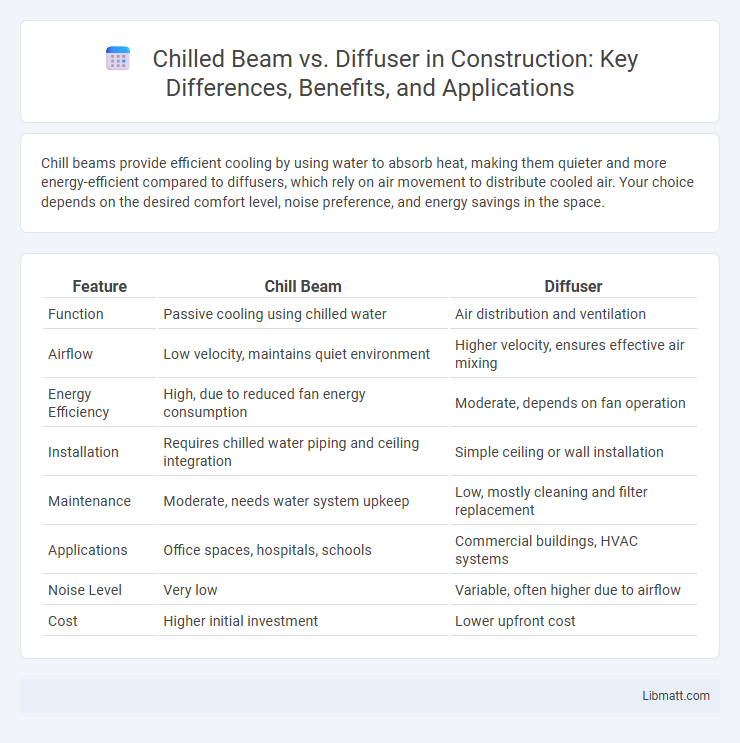Chill beams provide efficient cooling by using water to absorb heat, making them quieter and more energy-efficient compared to diffusers, which rely on air movement to distribute cooled air. Your choice depends on the desired comfort level, noise preference, and energy savings in the space.
Table of Comparison
| Feature | Chill Beam | Diffuser |
|---|---|---|
| Function | Passive cooling using chilled water | Air distribution and ventilation |
| Airflow | Low velocity, maintains quiet environment | Higher velocity, ensures effective air mixing |
| Energy Efficiency | High, due to reduced fan energy consumption | Moderate, depends on fan operation |
| Installation | Requires chilled water piping and ceiling integration | Simple ceiling or wall installation |
| Maintenance | Moderate, needs water system upkeep | Low, mostly cleaning and filter replacement |
| Applications | Office spaces, hospitals, schools | Commercial buildings, HVAC systems |
| Noise Level | Very low | Variable, often higher due to airflow |
| Cost | Higher initial investment | Lower upfront cost |
Introduction to Chill Beams and Diffusers
Chill beams are HVAC devices designed to cool spaces by circulating chilled water through ceiling-mounted units that absorb heat from the room air. Diffusers distribute conditioned air evenly throughout a space by directing airflow from supply ducts into the room, ensuring optimal air mixing and comfort. Unlike diffusers, chill beams rely primarily on radiant cooling and natural convection rather than forced air movement for temperature control.
How Chill Beams Work
Chill beams work by circulating chilled water through embedded pipes, which absorb heat from the room air and naturally cool the space through convection and radiant cooling. Unlike diffusers that rely on forced air distribution, chill beams provide silent, energy-efficient cooling without creating drafts. Your interior climate benefits from improved comfort and reduced energy consumption with the strategic integration of chill beams.
How Diffusers Operate
Diffusers distribute conditioned air by directing airflow evenly throughout a space, utilizing strategically designed openings to ensure balanced air circulation and consistent temperature control. Unlike chill beams, which rely on natural convection and radiant cooling, diffusers actively disperse air, allowing precise regulation of indoor air quality and comfort levels. Your choice of diffuser impacts ventilation efficiency, noise levels, and overall HVAC system performance.
Key Differences Between Chill Beams and Diffusers
Chill beams and diffusers differ primarily in their cooling and air distribution methods; chill beams use passive cooling through water-cooled panels to absorb heat, while diffusers rely on forced air to circulate conditioned air into the space. Chill beams typically offer quieter operation and energy efficiency by minimizing fan use, in contrast to diffusers that depend on mechanical systems with higher energy consumption. The installation complexity of chill beams is higher due to integration with HVAC water systems, whereas diffusers are simpler to install within ducted air distribution networks.
Energy Efficiency Comparison
Chill beams offer higher energy efficiency compared to diffusers by utilizing natural convection to circulate cool air, reducing fan power consumption. Diffusers rely on forced-air systems with higher airflow rates, resulting in increased energy use for fans and ductwork. Consequently, chill beams lower operational costs and carbon footprint in HVAC systems by minimizing electricity demand.
Indoor Air Quality Impact
Chill beams enhance indoor air quality by providing efficient ventilation and reducing airborne contaminants through their integrated airflow systems. Diffusers primarily distribute air without directly impacting contaminant levels, potentially allowing stagnation if not properly designed. Therefore, chill beams offer superior control over indoor air quality by combining cooling and ventilation functions in one unit.
Installation and Maintenance Considerations
Chill beams require precise ceiling integration and connection to the building's HVAC water system, demanding professional installation and careful sealing to avoid leaks. Diffusers are typically easier to install, often fitting into standard ceiling grids with minimal adjustments and allowing straightforward access for routine cleaning and filter replacement. Your choice between chill beam and diffuser systems should consider not only installation complexity but also long-term maintenance requirements to ensure optimal performance and energy efficiency.
Cost Comparison: Initial and Long-Term
Chill beams typically have higher initial installation costs compared to diffusers due to their complex design and integrated cooling capabilities. Over the long term, chill beams can offer energy savings by reducing the need for air conditioning, potentially lowering operational expenses, while diffusers have lower upfront costs but may result in higher energy consumption. Your choice between a chill beam and diffuser should consider both immediate budget constraints and projected energy efficiency benefits.
Best Applications for Chill Beams vs Diffusers
Chill beams are best suited for large commercial spaces, such as offices and conference rooms, where efficient cooling with minimal noise and unobtrusive design is essential. Diffusers work well in residential areas and smaller rooms, providing even air distribution and flexibility in directional airflow control. Understanding your space's cooling needs and aesthetic preferences will help determine if a chill beam or diffuser is the most effective choice.
Choosing the Right Solution for Your Building
Selecting between a chill beam and a diffuser depends on factors such as building design, energy efficiency goals, and occupant comfort requirements. Chill beams provide efficient radiant cooling with minimal air movement, ideal for open-plan offices and spaces needing quiet operation. Diffusers offer versatile airflow distribution suitable for varied ceiling types and rapid temperature adjustments in dynamic environments.
Chill beam vs diffuser Infographic

 libmatt.com
libmatt.com